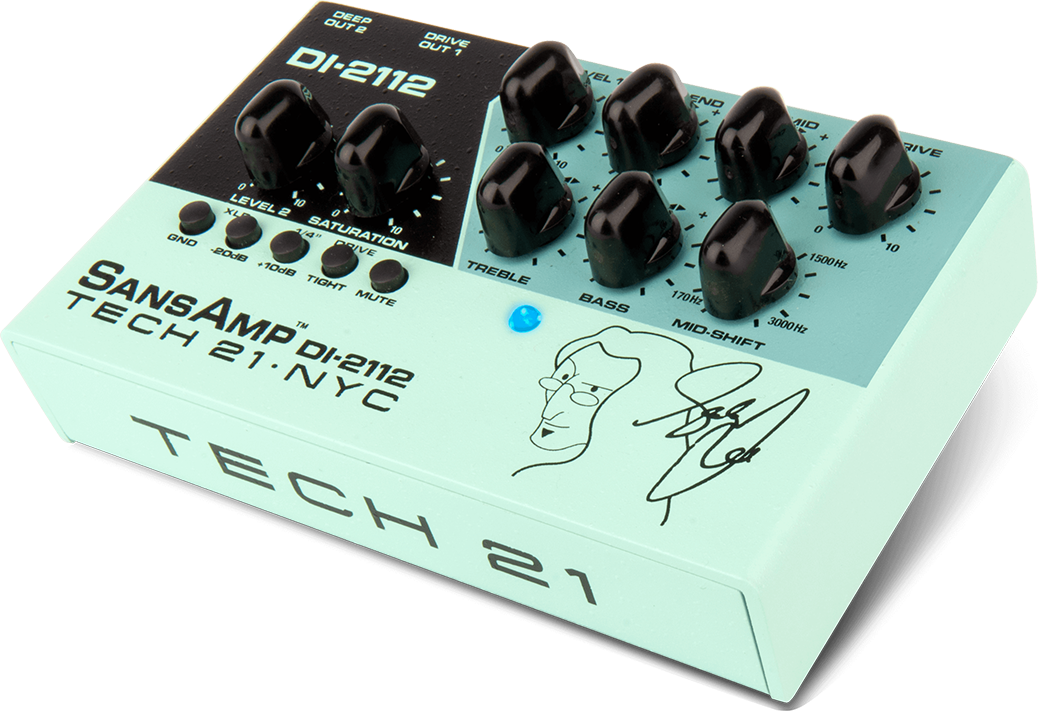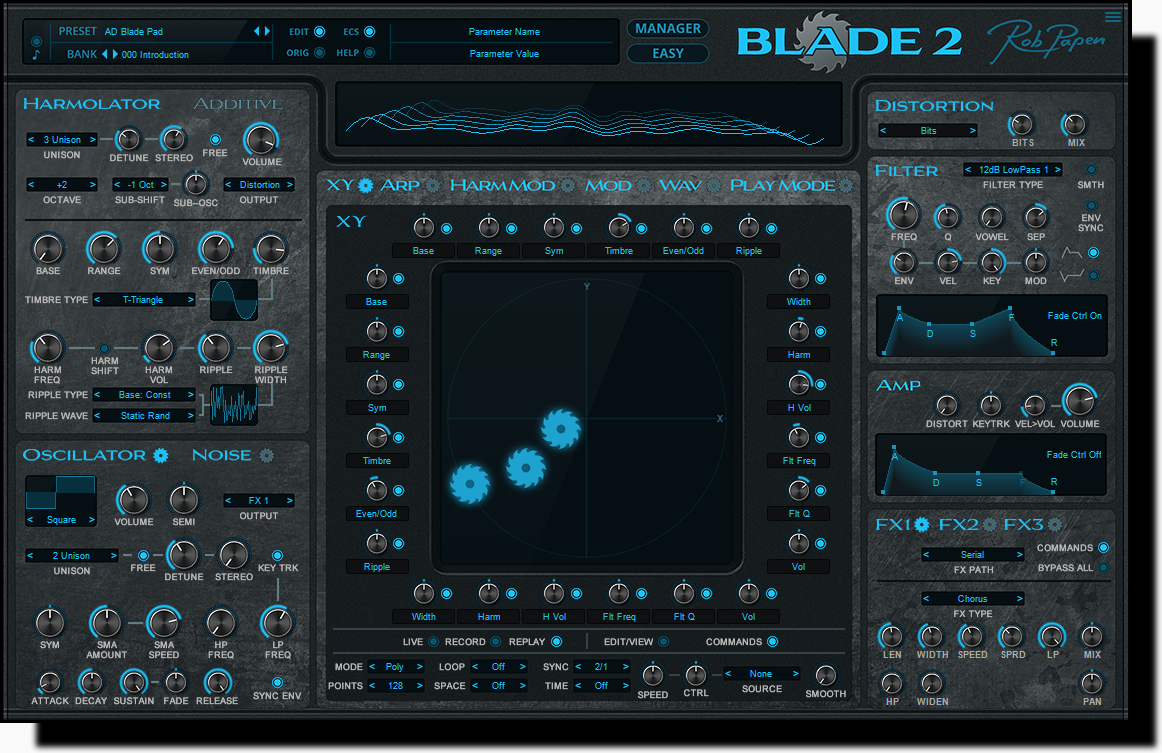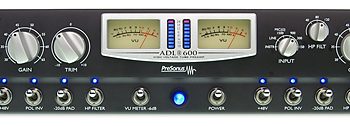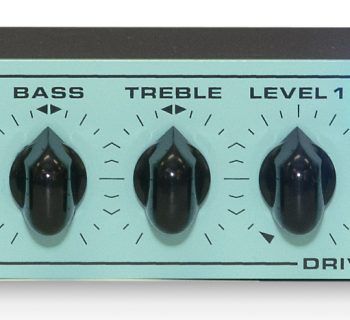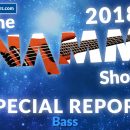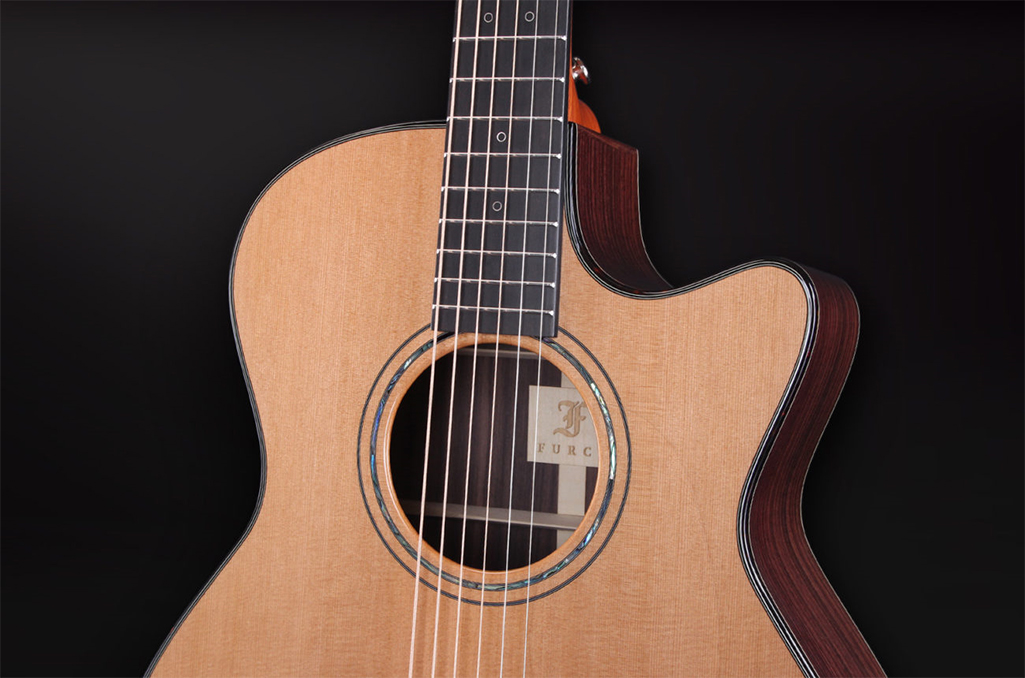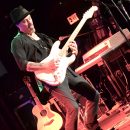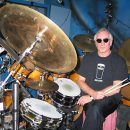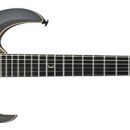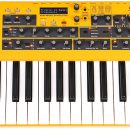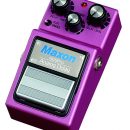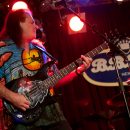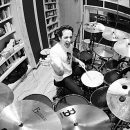
The Tech 21 Geddy Lee DI-2112 Signature SansAmp is a fraternal twin to the GED-2112 rack-mount bass preamp, but in a compact, tabletop or large pedalboard format. Geddy Lee collaborated with Tech 21 to engineer the portable version to be smaller and run on two nine-volt batteries so that it could provide a feature-rich solution that is still grab-and-go easy. It offers nearly all the features of the rack-mount preamp and more importantly, preserves all the tone! The Sansamp DI-2112 is fundamentally two DIs in one box that features all-analog SansAmp circuits.
The DI-2112 might deliver that special something your bass sound is missing as it can split your tone to two different amps/cabinets. And to be able to send two distinct tones to a front-of-house engineer that they can mix to taste can really up the quality of your live sound.
We love the rack-mounted GED-2112 Bass Preamp (reviewed here) and have already observed it installed in numerous studios. Having the flexibility to take that fabulous tone on the road in the DI-2112, either incorporated into your live rig or as a replacement for your live rig, is a wonderful thing.
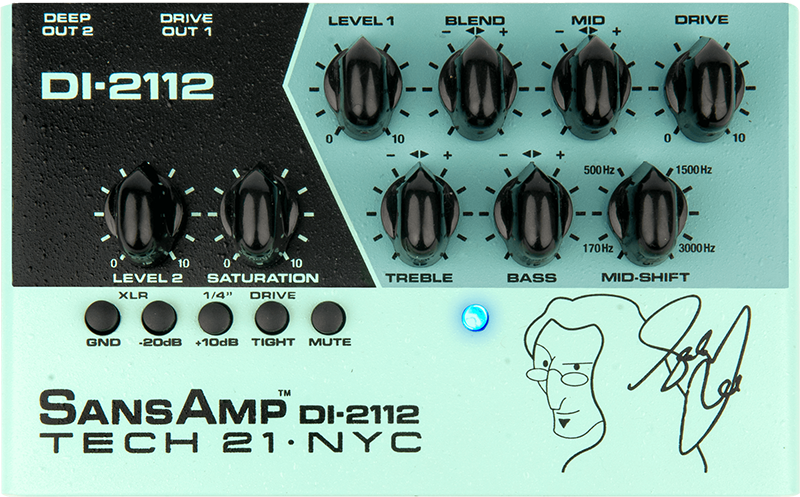
Features
The low profile, all-analog box with metal housing is built like a tank (as with all SansAmp devices, really). The Drive section of the unit has a Level control that controls Drive Out 1, a Blend control that blends the bass signal with the DI-2112 circuitry, and a Drive control that adjusts the amount of gain in the Overdrive. When the Blend is set to a minimum, Bass, Mid-shift, Mid and Treble level controls are still active: this is where you get your clear Bass voice. The tone controls are a Treble, Bass, Mid, and Mid-shift which is a parametric EQ control with a sweep ranging from 170Hz to 3.0kHz. The active Bass (80Hz) and Treble (3.2kHz) tone controls cut or boost +/- 12dB from the 12:00 position. The Mid control also is a +/- 12dB.
The Deep section is a second independent pre-amp that is running parallel with the Drive section. It has its own individual Saturation and Level controls, and the EQ curve was designed to Geddy Lee’s specifications. The Saturation control adjusts the overall amount of overdrive gain and the Level control adjusts the output level of the Deep section.
For the XLR Outputs, there is a -20dB pad to match the output to different level requirements, and there is a ground lift which we recommend leaving in the Out position (and engage if you have grounding issues). For the quarter-inch outputs there is a 0db or +10dB level selector switch. The Tight button is an added feature that came from the YYZ pedal. It tweaks the EQ in such a way as to deliver more definition in your tone.
The rear panel includes a dedicated tuner out and separate Drive and Deep outputs over both quarter-inch and XLR. You can actually use all four outputs at the same time if desired!
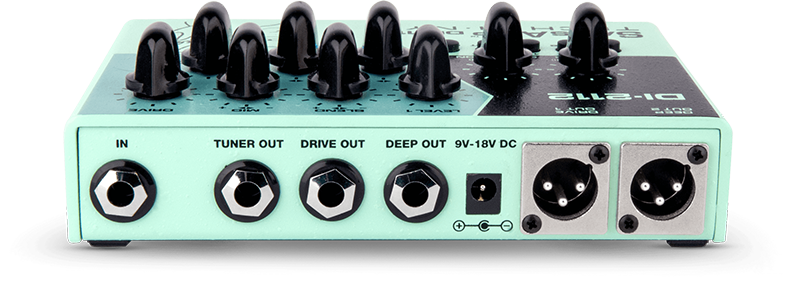 The oversized SansAmp (around the size of a small audio looper/switcher multifunction pedal) accepts 18V power via a standard 3.5mm center-negative barrel connector. Because it is designed as a dedicated preamp, you don’t need easy access to it on a pedalboard as there are no footswitches as with a more traditional preamp pedal design. For truly on-the-go gigs and session work, you can throw a pair of 9V batteries inside for the ultimate no-fuss setup. Just toss it (lovingly) into your backpack and go!
The oversized SansAmp (around the size of a small audio looper/switcher multifunction pedal) accepts 18V power via a standard 3.5mm center-negative barrel connector. Because it is designed as a dedicated preamp, you don’t need easy access to it on a pedalboard as there are no footswitches as with a more traditional preamp pedal design. For truly on-the-go gigs and session work, you can throw a pair of 9V batteries inside for the ultimate no-fuss setup. Just toss it (lovingly) into your backpack and go!
Usability
The DI-2112 small profile will fit conveniently on top of your rig, on your desk in your home studio, or on a large pedal board. The controls of the unit follow a familiar Tech 21 configuration.
The DI-2112 preamp is straightforward once you have chosen among the multiple options to set up… and assuming you’re comfortable running a pair of outputs either to a mixing board or two separate amplifiers.
When we were recording, we plugged the XLR outputs directly into our mixer, set our levels on both channels, had the -20dB switch engaged, kept the mixer with EQ levels flat, and used the DI-2112 to adjust. Being able to run it with batteries was convenient for our engineer because they were able to put the pedal directly on their mixing desk.
We connected the DI-2112 to a pair of QSC K12 powered PA speakers. We connected one speaker to the Drive output and one speaker to the Deep output and placed the speakers fairly close to each other. Ideally, for live, we could see bringing along a stereo (dual mono) power amp and a pair of bass speaker cabinets that we could stack.
Be aware that in a live or recording setting, if you adjust the levels on this preamp you are also adjusting the levels sent to the FOH or recording engineer. So once you get your sound dialed in, adjust volume from your power amp or your in-ears monitor mix—not from the DI-2112!
Sound
Because the DI-2112 is two DI boxes in one, sonically it enables bass players and engineers to really take control of their sound. The unit is the hub that connects your sound to multiple outputs. Here are just a few examples: You have a bass rig set up on stage, you’re going Drive Out, Deep Out, quarter-inch into your rig, and then also connecting the Drive Out and Deep Out XLR jacks to the front of house. Now, the sound from your stage setup can be accurately duplicated in the front of house.
For a smaller venue, how about same quarter-inch Drive Out and Deep Out to your rig, Drive Out to the front of house, Deep Out to a powered monitor for the drummer to hear you. Because it’s two direct boxes in one, don’t get locked into distorted bass on top and bottom end on the bottom. You have massive control out of both DIs and the controls are responsive and powerful. The blend control, which gives you a direct bass signal, is a third dimension that can help you achieve desired bass tones. So in our studio testing, sometimes we had a 100% SansAmp tone and sometimes we were 100% bass signal out the Drive output and utilizing the Deep Out controls for SansAmp tone.
In our test environment we played a variety of different active and passive basses. For our active basses we used a Fender Jazz-Ultra 5-string with an 18-volt active preamp, a Warwick Fretless Thumb Bass with an EMG BQC preamp system, a Yamaha BBNE2 Nathan East Signature 5-string, and a MusicMan Stingray. The passive basses included a Steve Harris Signature Fender Precision and a Geddy Lee Fender Jazz Bass. The Mark Bass rig we tested included for the Drive Out, the Little Mark 800 into a 2x10 (Mark Standard 10 2HF). The Deep Out went into a Mark Tube 800 into a 4x10 (Mark Standard 10 4HF).
Our next rig used QSC Power Amps and passive QSC PA speakers, along with some QSC powered PA speakers, two K12s. And for our FOH scenario, we also used some in-ear monitors through a PA system with no amps. In the studio with each bass we used, we tried every pickup combination, countless Q settings, and different styles of playing. You can definitely nail Geddy Lee’s signature tone with the DI-2112.
Besides the progressive rock bass sound of the seventies and early eighties, the DI-2112 can also produce some crystal clear, low noise, bass tones. Our sound through the Warwick Fretless Bass was warm, musical, and clean. We obtained this sound by using the mid-shift parametric EQ, the blend at around 40% on the pedal and the drive barely engaged. Out of the Drive Out 1 we got a nice, clean, nasal tone that was complemented by the round bottom out from the Deep Out 2, blended together to make one beautiful tone. We also enjoyed using the sample settings in the documentation for bass players like Jack Bruce, John Paul Jones, Les Claypool, and John Entwistle, and accurately recreated many of their legendary bass sounds. It seems we can get every 1960s and 70s bass tone from this box, in a pure, all-analog manner. No modeling here!
And finally for something completely different, listen up, keyboard players! We ran an old Roland Juno-106 into the 2112 and our synth bass parts were black-hole massive!!!
Documentation and Product Support
The Tech21 website is a good resource for most things you might need. The DI-2112 Owner’s Manual details the features, functions and setups available. It also includes a brief historical intro and provides a useful initial setup guide. Each of the functions and features were explained in straightforward text with illustrations, and as we mentioned above, the inclusion of specific sample settings was fabulous.
Price
The Tech 21 DI-2112 (MSRP $435) sells for $329. Compared with the simpler SansAmp DI V2 (reviewed here), the DI-2112 seems a bit pricey at first glance for what appears to be a pedal. However, it’s a fully implemented preamp and dual SansAmp device that is slightly less expensive than its rack-mounted sibling, so the pricing is a better or worse value depending on your perspective.
But whether you want to nail that classic Geddy Lee tone or simply have a flexible, great sounding DI that enables you to run a myriad of different amp setups, you will certainly get what you pay for here. The DI-2112 is a rugged, pro-level bass DI that will serve you well both on stage or in the studio.
Contact Information
Tech 21
www.tech21nyc.com

